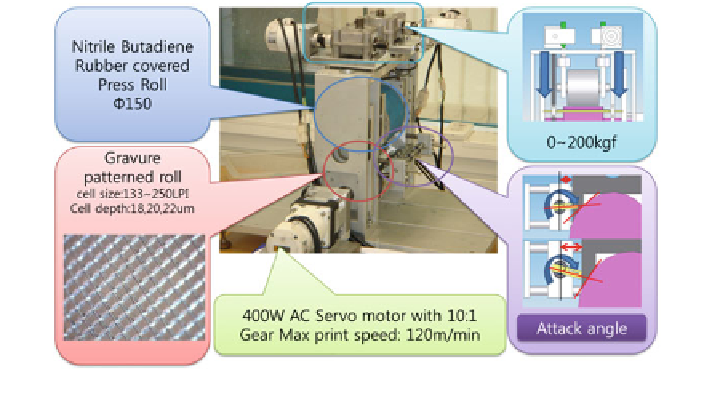Environmental Engineering Reference
In-Depth Information
Fig. 8
The gravure coating system and its coating parts
Uniform film is important to ensure proper device function. Example, the streak
patterns of the emissive material shown in Fig.
9
can cause electrical shorting
problems under the bias voltage. This unwanted streak pattern can be controlled by
adjusting the printing speed and ink viscosity. The viscosity of the solution can be
reduced by diluting the solution as discussed earlier for the emissive polymer. For
another example, the commonly used conductive polymer PEDOT:PSS solution is
also difficult to form a uniform film on the polymer substrate as shown in Fig.
10
.
In this case, since the solution is water-born and hydrophilic solution, it is difficult
to coat uniformly. The irregular pattern of the PEDOT:PSS layer can be controlled
by adding isopropyl alcohol (IPA) solution to reduce viscosity. Dilution with IPA
has better effect than that of adding a surfactant. However, it is hard to obtain an
appropriate film thickness by one time coating using a lower concentration solu-
tion. Therefore, in the case of using the viscous solution, the film quality is
sensitive to the coating instability caused by ink transfer in the contact coating
method. Due to the basic problems of the contact coating process, non-contact
coating methods will be introduced. Slot-die coating as a typical non-contact
coating is a good manufacturing tool for the large scale solar cells.
2 Characteristics of Roll-to-Roll Coated Functional Layers
Toward the Large Scale Devices
This section describes the roll-to-roll/blade-coating process with applications in
large area OPV and OLED devices. We discuss the requirements of the functional
layers (e.g., transparent electrode, hole extraction layer, charge separation layer,

Search WWH ::

Custom Search